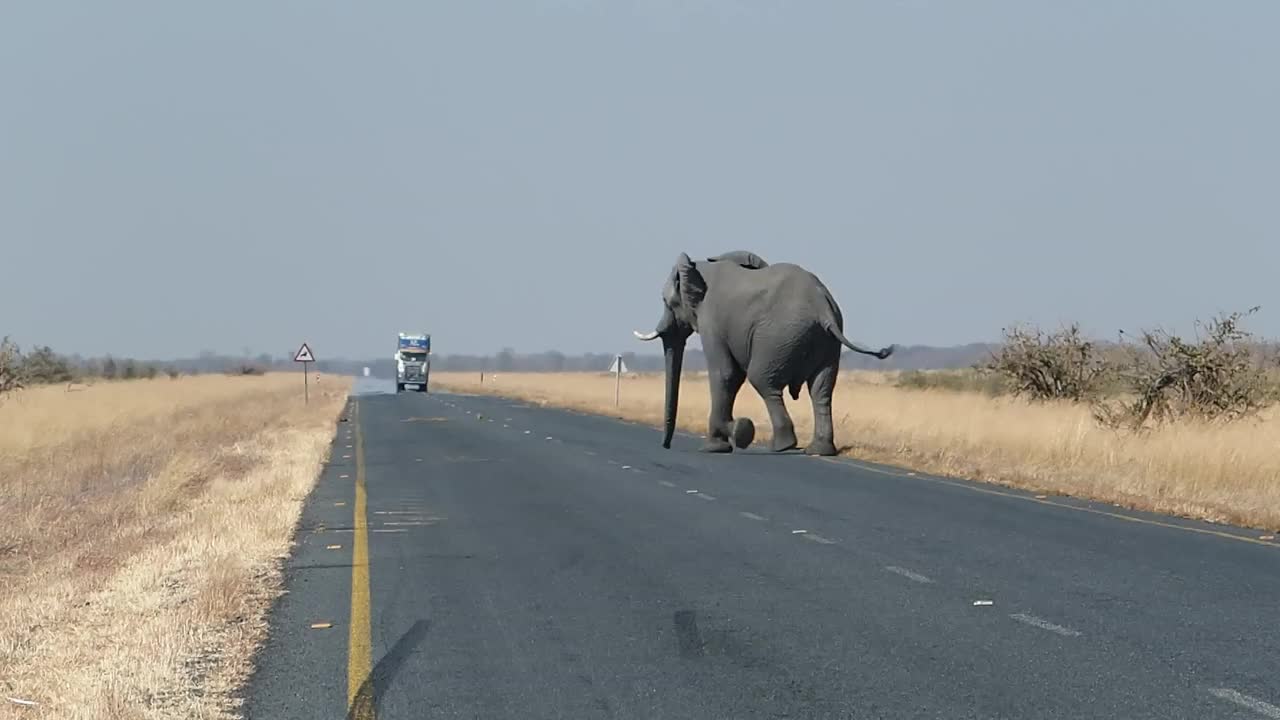Premium Only Content

Big Elephant Crossing the Road
In the early 1950s, carving out a road in the newly-created Tsavo National Park in Kenya involved “hacking through scrubland,” according to Dame Daphne Sheldrick in her memoir, Love, Life, and Elephants. Founder of the David Sheldrick Wildlife Trust, an organization that rescues orphaned elephants and rhinos, she describes the park landscape as “inhospitable country, covered in an entanglement of dense scrub vegetation infested with tsetse fly...” but “known for its diversity of indigenous species, including fearsome lions, breeding herds of elephants, and thousands of black rhinos.”
Today, the two-lane Mombasa-Nairobi highway (A109) dissects the park to form Tsavo East and Tsavo West. This causes problems for wildlife. Richard Leakey, Chairman of Kenya’s Wildlife Service, says that 18 elephants have been killed from collisions with trucks, and other wildlife become roadkill on a regular basis.
“We do want infrastructure where we can get to a good standard of living, and we do want wildlife,” said Leakey at a World Bank presentation in April 2017, where he spoke on current challenges to Kenya’s wildlife such as climate change, poaching, and infrastructure development. But he said reconciling the two needs facilitation and dialogue to move beyond pure opposition between conservationists and developers.
This Saturday, March 3, marks World Wildlife Day—an ideal time to consider whether infrastructure and wildlife can successfully intersect. This is especially important as roads and railways passing through wildlife-rich areas are on the increase across the globe.
Some experts say animals and vehicles can be managed if solutions are factored into development plans from the beginning.
Other specialists are skeptical.
“As we break off wildlife corridors because of infrastructure and increasing human populations we are putting the ecosystems on life support,” said World Bank lead economist Richard Damania. “There are some who believe we can manage these closed ecosystems, but it takes an immense amount of self-assurance and confidence in our understanding of ecosystems to suggest this with certainty.”
-
 41:56
41:56
CatfishedOnline
2 days agoKinky Man Sends 401k to Romance Scammer from Ghana!
25.1K9 -
 1:53:55
1:53:55
Nick Shirley
19 hours ago $6.45 earnedIRL Confronting Anti-Trump & Anti-Elon Protesters
28.6K109 -
 16:18
16:18
Tactical Advisor
1 day agoRetiring My Patrol Rifle | Old vs New
27.4K2 -
 22:29
22:29
JasminLaine
20 hours agoAwkward Silence After Poilievre FACT CHECKS Reporter—Carney’s Face SAYS IT ALL
29.9K36 -
 9:48
9:48
VSOGunChannel
20 hours ago $1.85 earned25% of ATF Getting Fired? SUPER ATF on Hold?
28.8K20 -
 11:09
11:09
ariellescarcella
23 hours ago"All 4 Of My Kids Are Trans" : NOOOOOO
27.7K30 -
 12:35
12:35
GoldenWebb
1 day ago $0.31 earnedMP5/K Super Safety
16.8K2 -
 2:45:42
2:45:42
Badlands Media
23 hours agoDevolution Power Hour Ep. 343: System Shock
174K157 -
 2:34:40
2:34:40
Sgt Wilky Plays
5 hours agoSunday Morning Coffee and games
17.4K1 -
 1:24:00
1:24:00
Man in America
1 day agoMarket Crash, Tariffs, USD Collapse: Trump's Plan to END the Old World Order? w/ John Perez
149K173